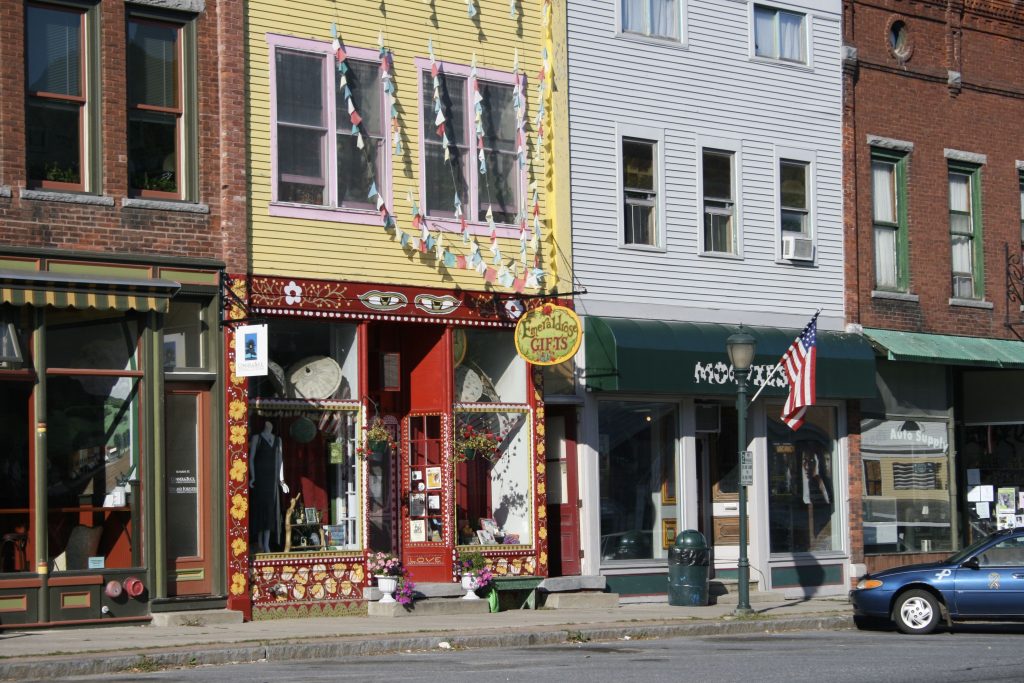VNRC Policy Position:
S.100 – Housing Opportunities Made for Everyone
S.100 is now law!
Read more from VTDigger
KEY TAKE-AWAYS
- Increasing housing choice and affordability in Vermont’s downtowns and village centers is a critical climate solution.
- In many towns across Vermont, local zoning regulations have had exclusionary impacts, including mandating sprawl development.
- Without reform, our current land use laws and resulting development patterns will lead to a worsening of our affordability crisis, farm and forest fragmentation, carbon emissions, and economic displacement of Vermonters – undermining the resilience of Vermont in the face of increasing natural disasters and other 21st century challenges.
- Large developments in areas with no or weak zoning regulations should still benefit from Act 250 review and a fair process for local appeals.
BACKGROUND
Development must be actively guided to the places where we already have or want to construct the necessary infrastructure for transportation, energy, communications, and human services, and away from the open spaces so critical to both our ecological and economic health.
– Vermont Climate Action Plan
VNRC has long advocated for a smart growth approach to planning and development that creates compact, walkable, transit-accessible communities with a range of affordable housing opportunities and choices. In Vermont, this approach builds on and maintains the state’s settlement pattern of higher-density downtown and village centers surrounded by farm, forest, and natural areas.
However, smart growth can be hindered by local zoning regulations; in fact, zoning has often had the impact of enforcing sprawl by mandating large lot sizes, restricting residential development to single family homes, and requiring excessive parking. These land use laws raise home prices, force development to consume unnecessarily more land, and push homes further away from town centers – requiring Vermonters to drive longer distances to get to where they need to go.

Due to limited land and housing supply, prices for both have continued to rise – resulting in unaffordability for many current and would-be Vermonters, and exacerbating existing inequities. At the same time, those who can afford to build often do so outside of town centers. To reduce sprawl and development pressure on forests and farmland, local zoning must be modernized to allow for smart growth housing where infrastructure already exists.
WHAT IS BEING PROPOSED?
By enabling development in smart growth areas, S.100 aims to reduce zoning-enforced sprawl and related environmental pressures1. VNRC supports the following key provisions:
- Enables dense, mixed-use, Vermont-scale community centers
- Density standards (e.g. allowing no more than 1 dwelling unit per acre) results in sprawl and prevents the development of affordable multi-family homes and walkable neighborhoods.
- Loosening density standards can alleviate our state’s housing shortage and affordability crisis by allowing compact housing development and infill.
- This policy proposes allowing 5+ homes per acre in areas with water/sewer service and closes loopholes that reduce density through other inconsistent dimensional standards.
- Minimizes excessive parking mandates
- Parking minimums (e.g. requiring 2 parking spaces per bedroom or dwelling unit) perpetuates sprawl and promotes auto-oriented (and emission-heavy) patterns of mobility.
- Capping or eliminating parking mandates can free up valuable downtown property, provide developers flexibility to add units, greenspace, or other needs, and reduce stormwater runoff and other environmental impacts of pavement. Developers are still able to provide as much parking as they see fit.
- This policy proposes limiting municipal requirements to no more than one parking space per dwelling unit in areas served by water/wastewater infrastructure. Municipalities can require 1.5 parking spaces for duplexes and multi-unit buildings in areas not served by water/wastewater and located more than 1/4 mile away from public parking.
- Removes limits on allowable uses
- Permitted uses for residential development are often restricted to single-family homes, which has the impact of unnecessary land consumption, racial and socio-economic segregation, and exclusion of a diversity of home types that can meet the needs of all income levels and needs.
- Increasing the flexibility of what can be built will enable creative housing solutions and historically common “missing middle” housing.
- This policy proposes to allow duplexes where single family homes are allowed, and fourplexes in areas with water/sewer service.
WHAT’S NEXT?
There are many multifaceted challenges related to our current lack of housing supply.
Last year, the legislature asked for two critical studies that will help to more effectively guide the state’s development patterns and target more systemic changes to our land use laws: the first will assess the State Designation Programs that support Vermont’s compact settlement areas, and the second will explore options to make necessary administrative and jurisdictional updates to the Act 250 program.
Together, these studies will provide an important opportunity to improve planning for and strategic investments in smart growth housing. VNRC recommends the legislature wait until the 2024 session to make jurisdictional changes to Act 250 and the designation program, when they will have more complete data and input from the Agency of Commerce & Community Development (ACCD) and the Natural Resources Board (NRB).
See More:
- Jon Groveman Testimony to SNRE
- Kati Gallagher Presentation to SNRE
- Brian Shupe Proposed Language Changes for SNRE
- Other notable provisions: funds rental rehabs, “missing middle” housing, mobile homes and parks, new housing resource navigator positions, bylaw modernization grants, and HomeShare Vermont; establishes project-based tax increment financing; limits how towns can regulate emergency shelters; improves enforcement of the Fair Housing & Public Accommodations Act; and, requires the Division of Fire Safety to report back on ways to reduce the cost of housing development.



